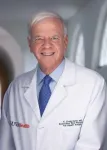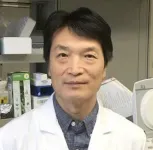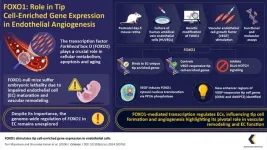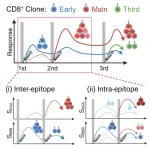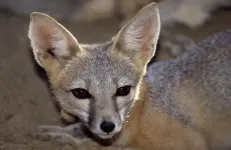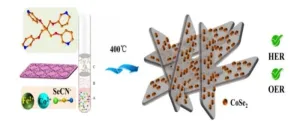(Press-News.org)
UVA Health researchers have received $2.8 million to advance their development of a high-tech way to save heart and dialysis patients from the need for multiple surgeries.
Researchers Lian-Wang Guo, PhD, and K. Craig Kent, MD, are pioneering a quick and gentle technique to “paint” tiny nanoparticles on transplanted veins to prevent the veins from becoming clogged in the future. This type of blockage often causes cardiovascular and dialysis patients to require repeated surgeries; approximately half of all heart bypass vein grafts fail and require another graft.
Dialysis patients, meanwhile, often require multiple surgeries to continue their lifesaving treatment. For some, this can lead to an endless series of surgeries on both arms and then the leg or collarbone area.
If UVA’s new approach is successful, it would be the first solution for these patients and a game-changing application of nanomedicine – medicine performed at an astonishingly small scale.
“Our approach is like deploying tiny guards to protect blood vessels from going bad, so that there is no need to open the body over and over again to repair them,” said Guo, of the University of Virginia School of Medicine’s Department of Surgery and the Robert M. Berne Cardiovascular Research Center. “It would save so much pain and money by sparing repeated surgeries.”
‘Painting’ for Better Health
Vascular surgeons commonly perform “revascularizations” to treat cardiovascular disease. This restores blood flow to areas that have lost it, or that are receiving an inadequate blood supply. For example, this might come in the form of a vein graft, which relocates a vein from one part of the body to another, such as from the leg to the heart for patients with heart failure.
People who need dialysis because of failing kidney function, meanwhile, undergo a surgical procedure to graft together an artery and a vein, typically in the arm, to provide dialysis access. This allows their blood to be removed from the body, cleansed of toxins and then returned. These dialysis connection points are called “arteriovenous fistulas,” or AVFs, and management of them in patients with end-stage renal disease is estimated to cost $5 billion per year in the United States alone.
Revascularizations are prone to fail with time. That’s because the procedures themselves encourage the same issue they’re trying to address: problems with blood flow. The surgery itself triggers the buildup of cells within the vessels that ultimately choke off blood supply once more.
Unfortunately, doctors have no good alternatives. There are no “standards of care” for AVFs because, despite much effort, nothing has been effective at keeping them open. Some AVFs never achieve sufficient blood flow to work properly at all. So patients’ only option is to have a new one installed when their old one fails – and they fail frequently.
“Coronary artery bypass grafting, called CABG, involves cutting open the patient’s chest for surgery on the heart. It is already so disruptive to the patient’s normal life, and imagine the surgery has to be repeated when the graft fails,” said Kent, a vascular surgeon who is also UVA Health’s chief executive officer and UVA’s executive vice president for health affairs. “Surgeons need an easy-to-use technology that enables them to just paint some protective nanoparticles onto grafts to keep the grafts functional so that repetitive surgeries become unnecessary.”
The Potential of EpiNanopaint
Kent, Guo and their team of UVA collaborators want to take a new approach. Their technique, called epiNanopaint, would let surgeons brush adhesive nanoparticles on the vessels during the initial surgery. These nanoparticles would contain a drug that would prevent the harmful growth of invasive cells.
Because the nanoparticles are sticky, they stay where they are placed, allowing long-term delivery of the drug exactly where needed. (That sort of precision is one of the great strengths of nanomedicine, a priority research area for the UVA School of Medicine and UVA’s under-construction Paul and Diane Manning Institute of Biotechnology.)
Guo and Kent will use the $2.8 million from the National Institutes of Health to study whether a particular enzyme, DOT1L, can be targeted with drugs to prevent the vessels from narrowing. They’ll also work with Shaoqin Gong, PhD, at the University of Wisconsin-Madison, to determine how best to use the painting approach to deliver the drug. “To make sure this technology will be safe and effective for patients, we have a lot more work to do,” Guo said.
If the research is successful, the new approach could be transformative for vast numbers of patients around the world. More than 400,000 open vascular reconstructions are performed in the United States alone each year, while the number of Americans receiving dialysis almost doubled between 2000 and 2018, to more than a half-million.
“Our goal is to develop the first therapy that can reduce graft failure rates in patients who receive vascular reconstruction surgeries,” Kent said. “This would be a tremendous benefit for patients everywhere.”
More information about the research is available here. The research team consists of Takuro Shirasu, Nisakorn Yodsanit, Jing Li, Yitao Huang, Xiujie Xie, Runze Tang, Qingwei Wang, Mengxue Zhang, Go Urabe, Amy Webb, Yuyuan Wang, Xiuxiu Wang, Ruosen Xie, Bowen Wang, Kent, Shaoqin Gong and Guo.
To keep up with the latest medical research news from UVA, subscribe to the Making of Medicine blog at http://makingofmedicine.virginia.edu.
END
The human vascular system, a complex network of blood vessels, plays an essential role in maintaining health. Understanding the molecular mechanisms underlying vascular development is important for tackling age-related disorders. The Forkhead box O (FOXO1) transcription factor is crucial in processes related to aging, cellular metabolism, and apoptosis. Despite its significance, the comprehensive regulation of FOXO1 across the genome in endothelial cells (EC) has not been investigated.
In a new paper published in iScience in February 2024, a research team from Kumamoto University ...
Scope
For decades, robotic systems have played a pivotal role in nurturing the growth of tissue-engineered constructs in controlled environments through the provision of mechanical stimulation. The importance of physical stresses in tissue maturation is not only intuitive from our own bodily experiences but is also supported by a growing body of mechanotransduction research. However, experimental studies have predominantly remained confined to basic in vitro setups, hampering our ability to produce functional grafts that can translate into clinical practice. Emerging evidence suggests that replicating physiological stresses more faithfully could further enhance the functionality of tissue ...
mRNA vaccines developed against the spike glycoprotein of severe acute respiratory syndrome type 2 coronavirus (SARS-CoV-2), displayed remarkable efficiency in combating coronavirus 19 (COVID-19). These vaccines work by triggering both cellular and humoral immune responses against the spike protein of the virus. Cellular immunity may play a more protective role than humoral immunity to variants of concerns (VOC) against SARS-CoV-2, as it targets the conserved regions of spike protein and possibly cross-reacts with other variants.
Since a single spike epitope is recognized by multiple T-cell clones, the ...
Climate change is driving both the loss of biodiversity and the need for clean, renewable energy. It is also shifting where species are expected to live in the future. Yet these realities are rarely considered together. Where can clean energy projects be built without impacting the future habitat ranges of threatened and endangered species?
A study from the University of California, Davis, examines this question by overlaying renewable energy siting maps with the ranges of two species in the southwestern United States: the iconic and climate-vulnerable ...
In the space of just a few seconds, a person walking down a city block might check their phone, yawn, worry about making rent, and adjust their path to avoid a puddle. The smell from a food cart could suddenly conjure a memory from childhood, or they could notice a rat eating a slice of pizza and store the image as a new memory.
For most people, shifting through behaviors quickly and seamlessly is a mundane part of everyday life.
For neuroscientists, it’s one of the brain’s most remarkable capabilities. That’s because different activities require the brain to use different combinations of its many regions and billions of neurons. How ...
By Gretchen Schrafft, Science Communications Specialist, Robert J. & Nancy D. Carney Institute for Brain Science
PROVIDENCE, R.I. [Brown University] — Imagine a busy restaurant: dishes clattering, music playing, people talking loudly over one another. It’s a wonder that anyone in that kind of environment can focus enough to have a conversation. A new study by researchers at Brown University’s Carney Institute for Brain Science provides some of the most detailed insights yet into the brain mechanisms that help people pay attention amid such distraction, as well as what’s ...
The body's inability to produce enough insulin or use it effectively often results in type 2 diabetes (T2D), a chronic disease affecting hundreds of millions of people around the globe. Disease management is crucial to avoid negative long-term outcomes, such as limb amputation or heart disease. To counteract adverse consequences, it is crucial that patients have good knowledge about the day-to-day management of the disease.
A team of researchers in Portugal has now assessed how many patients – both insulin-treated and not insulin-treated – have this crucial knowledge about T2D. They published their findings in Frontiers in Public Health.
“Our main motivation ...
Smaller class sizes in schools are failing to increase the resilience of children from low-income families, according to a study published in the peer-reviewed International Journal of Science Education.
Data on more than 2,700 disadvantaged secondary (high) school students shows that minimizing pupil numbers in classrooms does not lead to better grades. Reducing class sizes could even decrease the odds of children achieving the best results, say the study authors.
The quantity of teachers also does not increase the odds of pupils from the poorest backgrounds achieving academically, despite concerns over staff shortages in schools.
Instead, the researchers ...
Transition metal selenides have been considered to be a good choice for electrocatalytic water splitting. In addition, Metal-organic frameworks (MOFs) have been used to make catalysts with good electrocatalytic capabilities. Traditionally, the MOF-derived selenides are produced via the self-sacrificing MOF template methods. However, this strategy is high-energy consuming, and it is difficult to precisely control the structure and component homogeneity of the product during pyrolysis.
A research group of Wang-ting Lu, Fan Yu, and Yun Zheng ...
How extreme weather and climate events change is an intriguing issue in the context of global warming. As IPCC AR6 points out, cold extremes have become less frequent and less severe since the 1950s, mainly driven by human-induced climate change. However, cold extremes could also exhibit robust interdecadal changes at regional scale.
A recent study by researchers from the Institute of Atmospheric Physics, Chinese Academy of Sciences, presents robust interdecadal changes in the number of extreme cold days in winter over North China during 1989–2021, and the findings have been published in Atmospheric and Oceanic Science Letters. ...
